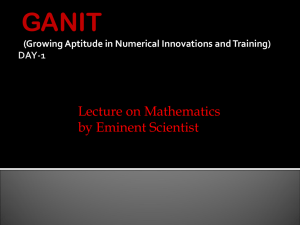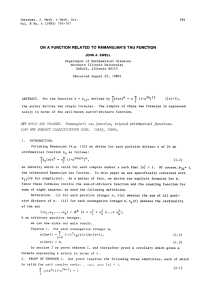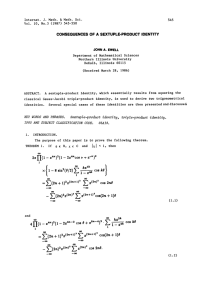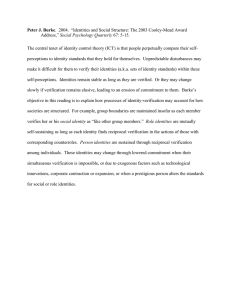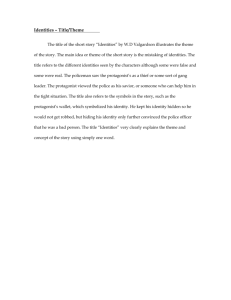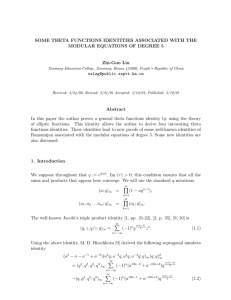Bulletin of Mathematical Analysis and Applications ISSN: 1821-1291, URL:
advertisement
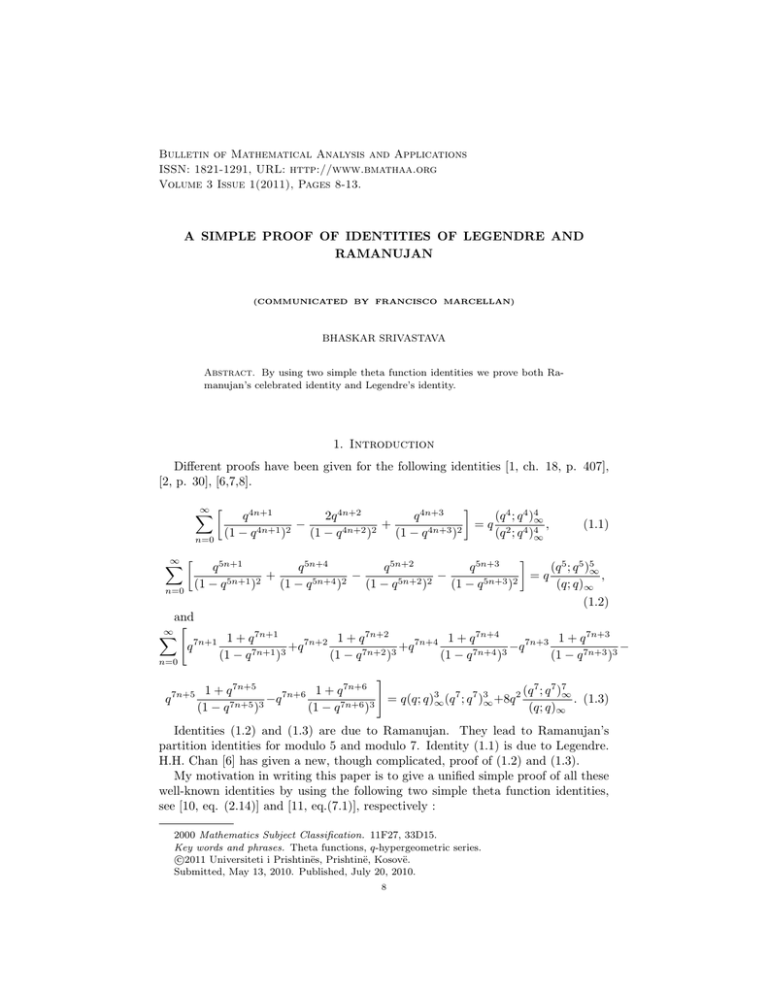
Bulletin of Mathematical Analysis and Applications ISSN: 1821-1291, URL: http://www.bmathaa.org Volume 3 Issue 1(2011), Pages 8-13. A SIMPLE PROOF OF IDENTITIES OF LEGENDRE AND RAMANUJAN (COMMUNICATED BY FRANCISCO MARCELLAN) BHASKAR SRIVASTAVA Abstract. By using two simple theta function identities we prove both Ramanujan’s celebrated identity and Legendre’s identity. 1. Introduction Different proofs have been given for the following identities [1, ch. 18, p. 407], [2, p. 30], [6,7,8]. ∞ X n=0 ∞ X n=0 n=0 (1.1) q 5n+4 q 5n+2 q 5n+3 q 5n+1 (q 5 ; q 5 )5∞ + − − = q , (1 − q 5n+1 )2 (1 − q 5n+4 )2 (1 − q 5n+2 )2 (1 − q 5n+3 )2 (q; q)∞ (1.2) and " ∞ X q 4n+1 2q 4n+2 q 4n+3 (q 4 ; q 4 )4∞ − + , = q (1 − q 4n+1 )2 (1 − q 4n+2 )2 (1 − q 4n+3 )2 (q 2 ; q 4 )4∞ q 7n+1 1 + q 7n+1 1 + q 7n+2 1 + q 7n+4 1 + q 7n+3 +q 7n+2 +q 7n+4 −q 7n+3 − 7n+1 3 7n+2 3 7n+4 3 (1 − q ) (1 − q ) (1 − q ) (1 − q 7n+3 )3 7n+6 1 + q 7n+5 7n+6 1 + q q 7n+5 −q (1 − q 7n+5 )3 (1 − q 7n+6 )3 # = q(q; q)3∞ (q 7 ; q 7 )3∞ +8q 2 (q 7 ; q 7 )7∞ . (1.3) (q; q)∞ Identities (1.2) and (1.3) are due to Ramanujan. They lead to Ramanujan’s partition identities for modulo 5 and modulo 7. Identity (1.1) is due to Legendre. H.H. Chan [6] has given a new, though complicated, proof of (1.2) and (1.3). My motivation in writing this paper is to give a unified simple proof of all these well-known identities by using the following two simple theta function identities, see [10, eq. (2.14)] and [11, eq.(7.1)], respectively : 2000 Mathematics Subject Classification. 11F27, 33D15. Key words and phrases. Theta functions, q-hypergeometric series. c 2011 Universiteti i Prishtinës, Prishtinë, Kosovë. Submitted, May 13, 2010. Published, July 20, 2010. 8 A SIMPLE PROOF OF IDENTITIES OF LEGENDRE AND RAMANUJAN 0 θ1 θ1 !0 ∞ X q n e−2iz q n e2iz + 4 , (z|q) = 4 (1 − q n e2iz )2 (1 − q n e−2iz )2 n=1 n=0 ∞ X 9 (1.4) and 0 θ1 θ1 !0 0 θ1 θ1 (a|q) − !0 0 2 (b|q) = θ1 (q) θ1 (a − b|q)θ1 (a + b|q) . θ12 (a|q)θ12 (b|q) (1.5) 2. Basic Preliminaries Throughout this paper we use q to denote e2πiτ , Im(τ ) > 0. We will use the following standard q-notation, |q| < 1: (a; q k )n = (1 − a)(1 − aq k ).......(1 − aq k(n−1) ), n ≥ 1 ∞ Y (a; q k )∞ = (1 − aq nk ), (2.1) (2.2) n=0 (a, b, c....; q)∞ = (a; q)∞ (b; q)∞ (c; q)∞ ...... Easily, for any integer n > 0 (2.3) (a, aq, ....., aq n−1 ; q n )∞ = (a; q)∞ . Jacobi theta function θ1 (z|q) is defined as [14, p.469] (2.4) ∞ X 1 θ1 (z|q) = −iq 8 (−1)n q n(n+1) 2 e(2n+1)iz (2.5) n=−∞ 1 = 2q 8 ∞ X (−1)n q n(n+1) 2 sin(2n + 1)z. (2.6) n=0 From (2.6), we have θ1 (−z|q) = −θ1 (z|q). (2.7) The function θ1 (z|q) can also be expressed in terms of an infinite product 1 θ1 (z|q) = 2q 8 sinz(q; q)∞ (qe2iz ; q)∞ (qe−2iz ; q)∞ 1 = iq 8 e−iz (q; q)∞ (e2iz ; q)∞ (qe−2iz ; q)∞ . (2.8) (2.9) We define θ1 (q) = θ1 (0|q) . Differentiating (2.8) with respect to z and then puttingz = 0, we have 0 0 1 θ1 (q) = θ1 (0|q) = 2q 8 (q; q)3∞ . (2.10) (2.11) From (2.9) and (2.7) respectively, we have k−4n θ1 nπτ |q k = iq 8 (q k ; q k )∞ (q n ; q k )∞ (q k−n ; q k )∞ , (2.12) 10 BHASKAR SRIVASTAVA θ1 −nπτ |q k = −θ1 nπτ |q k . (2.13) Taking n = 1,k = 5, and n = 2,k = 5 in (2.12) and then multiplying the two resulting identities, we get 1 θ1 πτ |q 5 θ1 2πτ |q 5 = −q − 4 (q; q)∞ (q 5 ; q 5 )∞ . Ramanujan defined general theta function f (a, b)as ∞ X f (a, b) = a n(n+1) 2 b n(n−1) 2 (2.14) , |ab| < 1. n=−∞ We then have [1, p. 35, Entry 19] f (a, b) = (−a; ab)∞ (−b; ab)∞ (ab; ab)∞ . 3. Proof of Identities (1.1) and (1.2) Making q → q 4 and then setting z = πτ and z = 2πτ, respectively, in (1.4), to obtain 0 θ1 θ1 !0 (πτ |q 4 ) = 4 ∞ X ∞ X q 4n+1 q 4n−1 + 4 4n+1 2 (1 − q ) (1 − q 4n−1 )2 n=0 n=1 (3.1) ∞ X q 4n−2 q 4n+2 + 4 . (1 − q 4n+2 )2 (1 − q 4n−2 )2 n=1 n=0 (3.2) and 0 θ1 θ1 !0 (2πτ |q 4 ) = 4 ∞ X Writing n + 1for n in the second summation on the right hand side of equation (3.1) and (3.2) and then subtracting (3.2) from (3.1), we have 0 !0 0 !0 ∞ X 2q 4n+2 q 4n+3 q 4n+1 − + . (1 − q 4n+1 )2 (1 − q 4n+2 )2 (1 − q 4n+3 )2 n=0 (3.3) This identity we proved in [13, eq. (7(ii))]. Making q → q 4 and then taking a = πτ , b = 2πτ in (1.5), we have θ1 θ1 θ (πτ |q )− 1 θ1 4 0 θ1 θ1 (2πτ |q 4 ) = 4 !0 0 (πτ |q 4 ) − θ1 θ1 !0 0 (2πτ |q 4 ) = θ1 q 4 2 θ1 (−πτ |q 4 )θ1 (3πτ |q 4 ) θ12 (πτ |q 4 )θ12 (2πτ |q 4 ) (q 4 ; q 4 )4∞ . (3.4) (q 2 ; q 4 )4∞ We have used (2.11) and (2.12) in simplifying the right hand side of the above identity. From (3.3) and (3.4), we have = 4q ∞ X n=0 2q 4n+2 q 4n+3 (q 4 ; q 4 )4∞ q 4n+1 − + = q , (1 − q 4n+1 )2 (1 − q 4n+2 )2 (1 − q 4n+3 )2 (q 2 ; q 4 )4∞ A SIMPLE PROOF OF IDENTITIES OF LEGENDRE AND RAMANUJAN 11 which is (1.1). Now we prove (1.2) using the same identity (1.4). Making q → q 5 and then setting z = πτ and z = 2πτ, respectively, in (1.4), and then substracting, we have !0 !0 0 0 ∞ X q 5n+4 q 5n+2 q 5n+3 θ1 θ1 q 5n+1 5 + − − (πτ |q )− (2πτ |q 5 ) = 4 θ1 θ1 (1 − q 5n+1 )2 (1 − q 5n+4 )2 (1 − q 5n+2 )2 (1 − q 5n+3 )2 n=0 ∞ X n =4 5 n=1 qn , (1 − q n )2 (3.5) where n5 is Legendre symbol. Making q → q 5 and then taking a = πτ and b = 2πτ in (1.5), using (2.11) and (2.14), we have 0 θ1 θ1 !0 0 (πτ |q 5 ) − θ1 θ1 !0 (2πτ |q 5 ) = 4q (q 5 ; q 5 )5∞ . (q; q)∞ (3.6) From (3.5) and (3.6), we have ∞ X n n=1 5 (q 5 ; q 5 )5∞ qn = q , (1 − q n )2 (q; q)∞ which is (1.2). 4. Proof of Identity (1.3) In proving the identity (1.3) we use the same theta function identity (1.4) only we differentiate partially (1.4) with respect to z. Differentiate partially with respect to z both side of (1.4), to get 0 θ1 θ1 !00 (z|q) = 8i ∞ ∞ X X q n e2iz (1 + q n e2iz ) q n e−2iz (1 + q n e−2iz ) − 8i . (1 − q n e2iz )3 (1 − q n e−2iz )3 n=0 n=1 (4.1) Making q → q 7 and then writing n + 1 for n in the second summation on the right hand side of (4.1), we get !00 ∞ ∞ X X q 7n e2iz (1 + q 7n e2iz ) q 7n+7 e−2iz (1 + q 7n+7 e−2iz ) (z|q ) = 8i − 8i . 7n 2iz 3 (1 − q e ) (1 − q 7n+7 e−2iz )3 n=0 n=0 (4.2) Put z = πτ and z = 2πτ, respectively, in (4.2) and add to get 0 θ1 θ1 7 0 θ1 θ1 = 8i !00 0 (πτ |q 7 ) + θ1 θ1 !00 (2πτ |q 7 ) ∞ ∞ X X q 7n+1 (1 + q 7n+1 ) q 7n+6 (1 + q 7n+6 ) − 8i (1 − q 7n+1 )3 (1 − q 7n+6 )3 n=0 n=0 12 BHASKAR SRIVASTAVA + 8i ∞ ∞ X X q 7n+5 (1 + q 7n+5 ) q 7n+2 (1 + q 7n+2 ) − 8i . 7n+2 3 (1 − q ) (1 − q 7n+5 )3 n=0 n=0 (4.3) Now put z = 3πτ in (4.2) and subtract from (4.3) to obtain 0 θ1 θ1 !00 0 (πτ |q 7 ) + θ1 θ1 !00 0 (2πτ |q 7 ) − θ1 θ1 !00 (3πτ |q 7 ) = 8i ∞ ∞ X X q 7n+1 (1 + q 7n+1 ) q 7n+6 (1 + q 7n+6 ) − 8i 7n+1 3 (1 − q ) (1 − q 7n+6 )3 n=0 n=0 +8i ∞ ∞ X X q 7n+5 (1 + q 7n+5 ) q 7n+2 (1 + q 7n+2 ) − 8i 7n+2 3 (1 − q ) (1 − q 7n+5 )3 n=0 n=0 − 8i ∞ ∞ X X q 7n+3 (1 + q 7n+3 ) q 7n+4 (1 + q 7n+4 ) + 8i . (1 − q 7n+3 )3 (1 − q 7n+4 )3 n=0 n=0 (4.4) For evaluating the left hand side of (4.4) we use the second identity (1.5). Differentiating partially both side of (1.5) with respect to a and then putting b = a, and making q → q 7 , we obtain 0 θ1 θ1 !00 0 (a|q 7 ) = θ1 q 7 3 θ1 (2a|q 7 ) . θ14 (a|q 7 ) (4.5) Taking a = πτ , 2πτ and 3πτ, respectively, in (4.5) and using (2.11) and (2.12), we have !00 0 (q 7 ; q 7 )9∞ (q 2 ; q 7 )∞ (q 5 ; q 7 )∞ (q 7 ; q 7 )∞ θ1 (πτ |q 7 ) = 8iq , θ1 (q; q 7 )4∞ (q 6 ; q 7 )4∞ (q 7 ; q 7 )4∞ !00 0 θ1 (q 7 ; q 7 )9∞ (q 3 ; q 7 )∞ (q 4 ; q 7 )∞ (q 7 ; q 7 )∞ (2πτ |q 7 ) = 8iq 2 , θ1 (q 2 ; q 7 )4∞ (q 5 ; q 7 )4∞ (q 7 ; q 7 )4∞ (4.6) (4.7) and 0 θ1 θ1 !00 (3πτ |q 7 ) = 8iq 3 (q 7 ; q 7 )9∞ (q; q 7 )∞ (q 6 ; q 7 )∞ (q 7 ; q 7 )∞ . (q 3 ; q 7 )4∞ (q 4 ; q 7 )4∞ (q 7 ; q 7 )4∞ (4.8) Using (4.6), (4.7) and (4.8) the left hand side of (4.4) equals " 8iq(q 7 ; q 7 )9∞ q 3 7 4 7 7 7 (q 2 ; q 7 )∞ (q 5 ; q 7 )∞ (q 7 ; q 7 )∞ 2 (q ; q )∞ (q ; q )∞ (q ; q )∞ + q − (q; q 7 )4∞ (q 6 ; q 7 )4∞ (q 7 ; q 7 )4∞ (q 2 ; q 7 )4∞ (q 5 ; q 7 )4∞ (q 7 ; q 7 )4∞ # 7 6 7 7 7 3 (q; q )∞ (q ; q )∞ (q ; q )∞ q 3 7 4 4 7 4 7 7 4 (q ; q )∞ (q ; q )∞ (q ; q )∞ f (−q 2 , −q 5 ) f (−q 3 , −q 4 ) f (−q, −q 6 ) + − q = 8iq 2 (q 7 ; q 7 )9∞ q −1 4 . f (−q, −q 6 ) f 4 (−q 2 , −q 5 ) f 4 (−q 3 , −q 4 ) (4.9) Using the following identity [4, eq.(4.22)] to evaluate the right hand side of (4.9) A SIMPLE PROOF OF IDENTITIES OF LEGENDRE AND RAMANUJAN (q; q)∞ (q 7 ; q 7 )2∞ 13 2 5 f (−q 3 , −q 4 ) f (−q, −q 6 ) −1 f (−q , −q ) q + −q 4 f 4 (−q, −q 6 ) f 4 (−q 2 , −q 5 ) f (−q 3 , −q 4 ) = f 4 (−q) +8 qf 4 (−q 7 ) we have 0 θ1 θ1 !00 0 7 (πτ |q ) + θ1 θ1 !00 0 7 (2πτ |q ) − θ1 θ1 !00 (3πτ |q 7 ) (q 7 ; q 7 )7∞ = 8i q(q; q)3∞ (q 7 ; q 7 )3∞ + 8q 2 . (q; q)∞ Now by (4.4) ∞ X " q 7n+1 n=0 7n+2 7n+4 7n+3 1 + q 7n+1 7n+2 1 + q 7n+4 1 + q 7n+3 1 + q +q +q −q − (1 − q 7n+1 )3 (1 − q 7n+2 )3 (1 − q 7n+4 )3 (1 − q 7n+3 )3 7n+6 7 7 7 1 + q 7n+5 7n+6 1 + q 3 7 7 3 2 (q ; q )∞ − q = q(q; q) (q ; q ) + 8q , ∞ ∞ (1 − q 7n+5 )3 (1 − q 7n+6 )3 (q; q)∞ which is (1.3). This identity has also been proved by Liu [9], using these two identities. q 7n+5 Acknowledgments. I am thankful to the Referee for his suggestions. References [1] G.E. Andrews and B.C. Berndt, Ramanujan’s Lost Notebook, Part I, Springer, New York, 2005. [2] W.N. Bailey, A note on two of Ramanujan’s formulae, Quart. J. Math. Oxford Ser. 3(1952), 29-31. [3] W.N. Bailey, A further note on two of Ramanujan’s formulae, Quart. J. Math. Oxford Ser. 3(1952), 158-160. [4] B.C. Berndt and L.-C. Zhang, A new class of theta-function identities originating in Ramanujan’s notebooks, J. Number Theory 48(1994), 224-242. [5] B.C. Berndt, Ramanujan’s Lost Notebooks, Part III, Springer-Verlag, New York, 1991. [6] H.H. Chan, New proofs of Ramanujan’s partition identities for moduli 5 and 7, J. Number Theory 53(1995), 144-159. [7] R. J Evans, Theta function identities, J. Math. Anal. Appl. 147 (1990), 97-121. [8] F.G. Garvan, A simple proof of Watson’s partition congruences for power of 7, J. Austral. Math. Soc. Ser A 36 (1984), 316-334. [9] Z.-G. Liu, On certain identities of Ramanujan, J. Number Theory 83(2000), 59-75. [10] Z.-G. Liu, Some theta function identities associated with modular equations of degree 5, Integers:Electronic Journal of Combinatorial Number Theory 1 (2001), A# 03, 14 pp. [11] Z.-G. Liu, Residue Theorem and theta function identities, Ramanujan Journal 5 (2001), 129-151. [12] S. Ramanujan, The Lost Notebook and other unpublished papers, Narosa, New Delhi, 1988. [13] Bhaskar Srivastava, Some theta-function identities, App. Math. and Computation, 187 (2007), 474-478. [14] E.T.Whittaker and G.N. Watson, A Course of Modern Analysis, 4th ed., Cambridge University Press, Cambridge, 1966. Lucknow E-mail address: bhaskarsrivastav@yahoo.com
